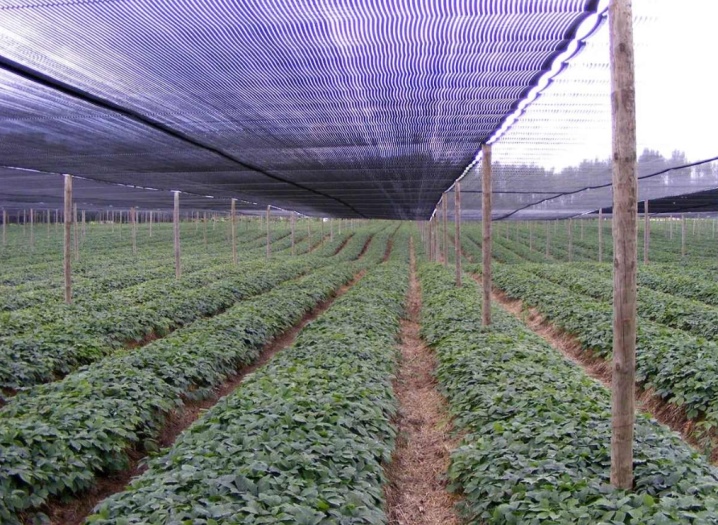Khaki mesh mounting technology
At first, it is recommended to schematically depict the future structure, carry out calculations and cut the material if necessary.
The installation process is similar to the construction of a plastic mesh fence, so the set of required tools will be the same.
After preparation, you should start marking and choosing material for supports.
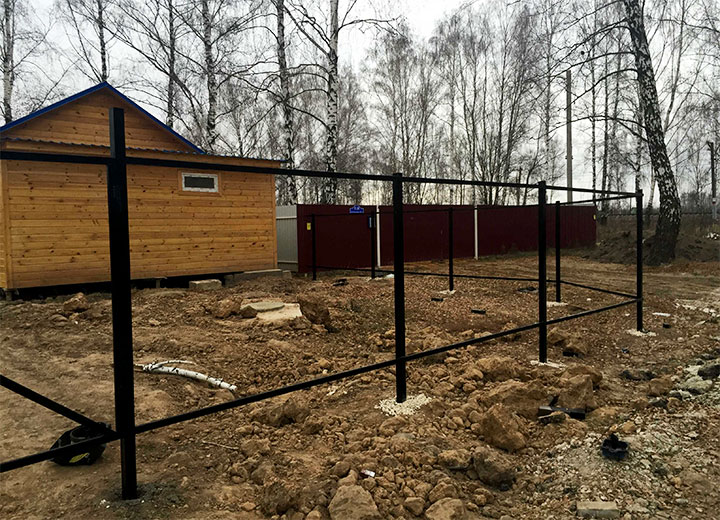
We attach the mesh to the fence
Mounting can be done in two ways:
- The canvas is fixed already to the previously erected fence made of chain-link or other material. An inexpensive frameless mesh will do. To do this, it is simply tied to the posts with metal wire.
- In this type of mount, camouflage is the main material for the fence. It is better to take a nylon-based mesh, because even over time it will not sag. A wire is pulled tightly between the pillars, which will serve as a guide, and the mesh is pulled from above, fixing it to the supports with plastic clamps or wire.
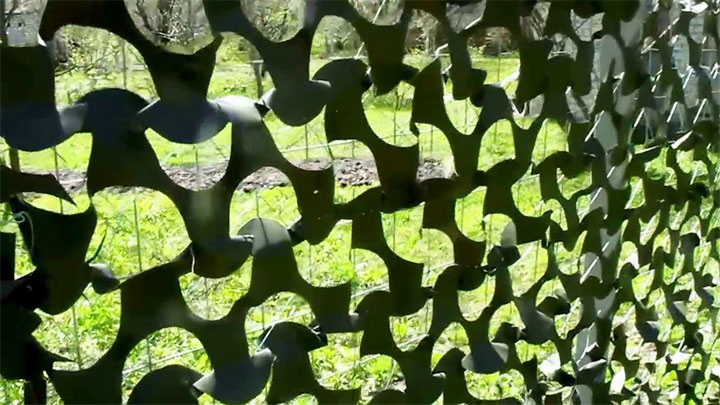
Manufacturers equip individual models of products with hooks, holes for fasteners, so their installation is simplified.
In terms of technical characteristics, such a mesh is not inferior to a chain-link, plastic or facade. This is a worthy alternative to the listed materials and the original version of the country fence.
With your own hands
It is quite easy to make a camouflage net with your own hands, you only need patience, perseverance and free time. In addition, you will need to buy a base, which is an excellent barrier net with a mesh size of 40x40 or 50x50 mm, as well as a piece of textile of the required size and painted in the desired color.
The protective net is stretched on the fence or along the wall of the house. The camouflage material is cut into strips and woven into the base. You can also use burlap, the individual fibers of which are collected in bundles and attached to the "frame". The process of cutting and weaving is clearly presented in the videos, which are collected in the corresponding article.
Views
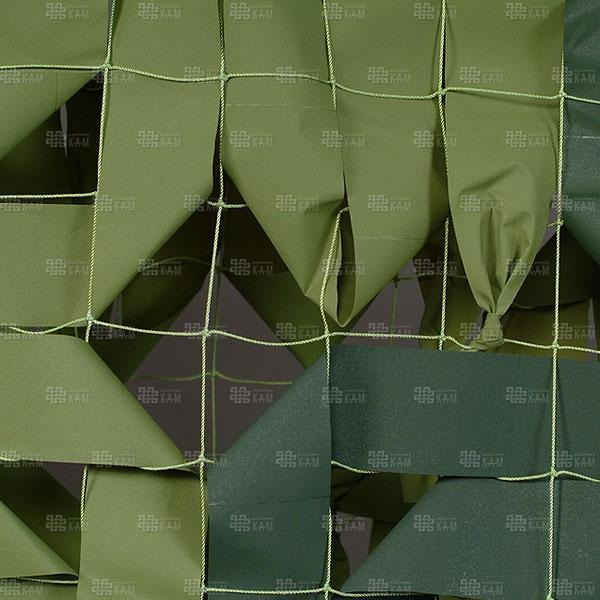
Camouflage mesh Standard. Photo Company K-A-M
There are quite a number of types of camouflage mesh. Different parameters are used to divide materials into groups:
- Series - a line of materials: Standard, Light, Fern, Landscape, Econ and Decor. Products of different series have individual characteristics, are used for the implementation of certain projects, and have specific color solutions.
- Colour. There are several of the most popular nets in shades: green (spruce); white (winter). Materials of some varieties have alternative names, most often other names are applied to materials that have more than one color in design: desert (beige / light beige); swamp (ocher / light and dark brown / green); wood (green / brown / black); ocean (light blue / blue / black / white).
-
Packing type
For masking large objects or decorating objects of significant size, camouflage coatings (canvases) are produced, consisting of several 3x6 elements and connected by threads that form rapidly opening seams.
: modules and rolls. Modules (pieces) of nets have different dimensions: the width varies from 1.5 to 4 m, the length is -2-6 m. The rolls have much larger dimensions, their width can be from 1.5 to 2.4 m, the length is 50 or 78 m.
- With a frame (base) and without. The frame is made of polyamide, nylon, polyurethane-coated textiles for a long service life. Frameless products are used as a temporary solution.

Econ camouflage mesh, density 65%. Photo Company K-A-M
- The degree of shading. Materials provide low, medium and high levels of shading.
- According to the types of imitation, nets are distinguished that have the following texture: for needles, grass, leaves, snow, water, individual colors are in demand.
Benefits of Application
As a fencing, camouflage mesh has other advantages:
- Due to its light weight, it can be easily pulled onto a previously installed fence without harm to the structure.
- The choice of colors, density of the canvas allows you to find a product that is suitable for areas with a different landscape.
- The service life exceeds 15 years.
- The strength of the mesh makes the structure resistant to strong gusts of wind and becomes a barrier to intruders.
- Depending on the purpose of the fence, you can choose a material with a different level of shading.
- Raw materials do not heat up in the sun.
- The construction will cost inexpensively, since you do not need to attract masters to help, but you can do everything yourself.
There are no disadvantages regarding the use of camouflage.
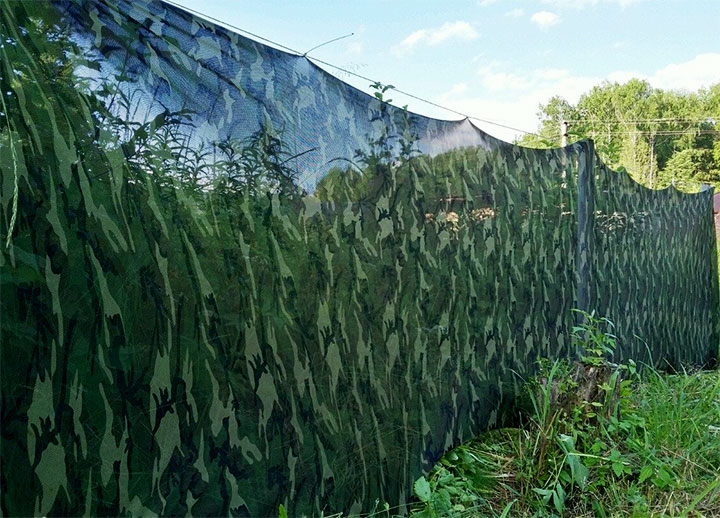
At the discretion of the owners, in the summer, you can pour over the mesh with a pressure of water to get rid of the dust that has settled on the surface and refresh it.
Manufacturing process what will be required
To obtain a quality product, you should strictly follow the order of work. In addition, the contractor will need to prepare or buy the following materials:
- frame materials;
- materials for external design;
- brush and paint or spray can (not for all cases).
Frame
First of all, the parameters of the frame (base) should be determined: the dimensions of the cells, the width and length of the canvas, the diameter of the cord. To answer these questions, you need to know for what purposes the finished product will be used: for camouflage hunting, for decorating fences, gazebos, awnings, decoration, etc.
Further, the performer has two options:
Buy a ready-made mesh: fishing, barrage or another, which will serve as a frame. Customers are provided with a wide selection of protective nets with the required parameters. This option is a great solution.
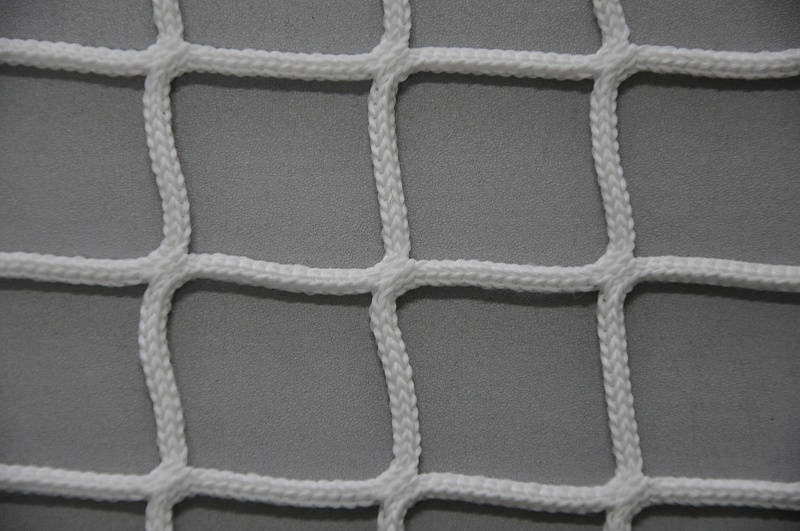
Nylon protective mesh
Knit or sew the base yourself to save money but time.
Thus, the preferred option is to purchase a ready-made mesh. It is recommended to buy a product made of nylon cord, which is durable and does not get confused.
Materials for external design
Before proceeding with the design of the frame, scald the homemade knitted base with boiling water and melt the ends of the cords. This will prevent knots from getting loose.
Various materials can be used for external design:
- scraps of camouflage fabric cut from purchased canvas;
- tow;
- sackcloth;
- yarn;
- threads;
- leaves, grass, thin branches, moss.
In addition, some performers use tarp tapes. The use of strips from plastic bottles is not the best solution if there is an intention to use the net for hunting. In other cases, this option is also possible.
Reference. It is not recommended to use fishing line, as it glares and gets tangled.
Burlap, yarn, threads get wet in the rain, their weight increases, which causes discomfort to the hunter.
Therefore, the best choice is synthetic fabric: nylon, nylon, etc.
Mountings
Fastening is done in different ways. The ribbons of the selected material are fixed to the frame by the weaving method, i.e. the flaps are tied to the base, as well as with glue or threads.
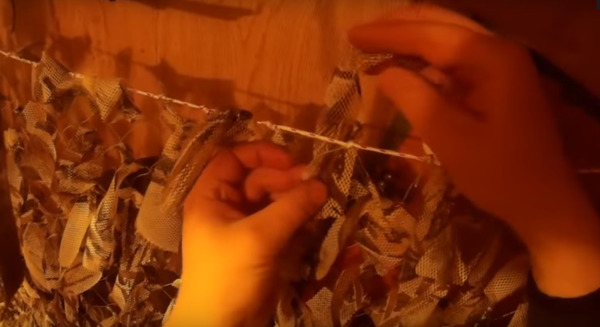
Fastening (binding) a tape made of synthetic cloth to the frame.
The first method is used in most cases, as it saves the most time.
How to weave correctly
Correct weaving of ribbons, threads or other forms of materials is an important task.The frame stretches and attaches, for example, to a fence or is located between posts driven into the ground
Ribbons, the size of which is different, for example 5x50 cm, are cut from one side to 1/3 of the length. For the uncut edge, the flaps are fastened. It is possible to make several cuts across the width. Thus, textiles acquire a natural, plant-like texture. The ribbons should be placed until the performer obtains the required density
The frame is stretched and attached, for example, to a fence or is located between posts driven into the ground. Ribbons, the size of which is different, for example 5x50 cm, are cut from one side to 1/3 of the length. For the uncut edge, the flaps are fastened. It is possible to make several cuts across the width. Thus, textiles acquire a natural, plant-like texture. The ribbons should be placed until the performer obtains the required density.
Special attention should be paid to the fastening of leaves and grass, which are recommended to be used in a set with tow or burlap, which have a similar color.
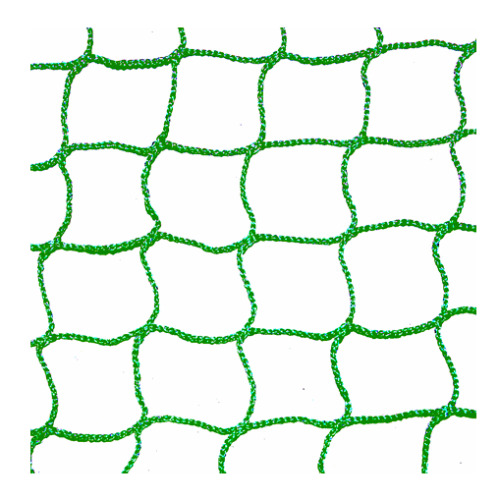
Small mesh nylon mesh
As a frame, it is necessary to choose grids with a small cell size. Fastening must be carried out in a chaotic manner. First, bundles of burlap are woven, then grass and twigs, and the leaves are attached last.
Painting
Painting is not always required. Processing is carried out during the manufacture of masks from all materials, with the exception of synthetic ones. The paint should also be applied in a chaotic manner, which ensures naturalness and better concealment. After applying the paint, the product must be allowed to dry and thoroughly ventilated.
Nuances of choice
The meshes may differ in their purpose. If you are equipping a canopy for horticultural crops, you should decide on the parameters of the density and light transmission of the material. There are several basic levels of mesh shading.
- 45% is a light version, such a grid transmits the sun's rays well and contributes to their uniform redistribution throughout the covering area. Such sheds are usually used for light-loving plants - melons, cucumbers, strawberries.
- 60% is a slightly denser canvas, transmits light, but protects from ultraviolet radiation. Suitable for vegetable crops - peppers, tomatoes, eggplants, cabbage.
- 70% are dense materials. These nets do not trap sunlight, but at the same time block the action of direct UV radiation. Usually used to cover greenhouses and greenhouses from the outside.
- 80% are rather dense nets that impede the passage of light and sunlight. Not recommended for use in gardens and vegetable gardens, as they can cause the death of the crop. Suitable for creating canopies over gazebos and car shelters.
- 90% - the maximum degree of protection, optimal for sheltering important objects. It is often found as a canopy on the summer verandas of cafes and restaurants.
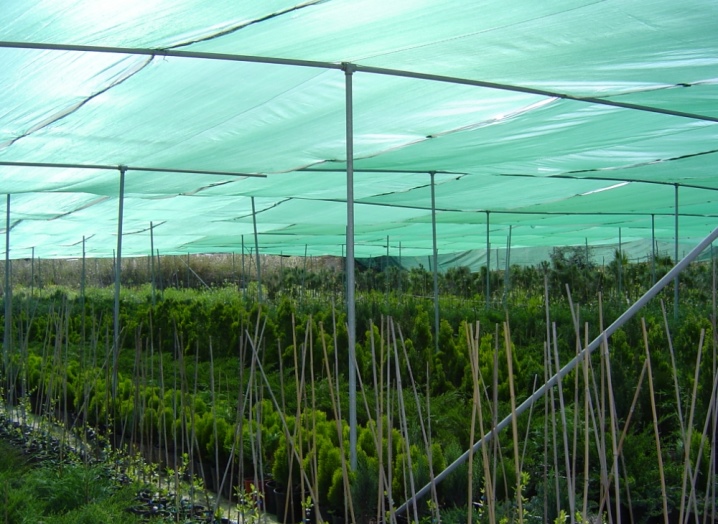
When choosing a net for plant protection, an important factor in the selection is the color of the product.
Red - stimulates plant growth, accelerates the process of flowering and ripening of fruits, increases the size of the crop. If we compare the growth of the same plant under nets of different shades, then the best indicators will be for crops under red shelter.
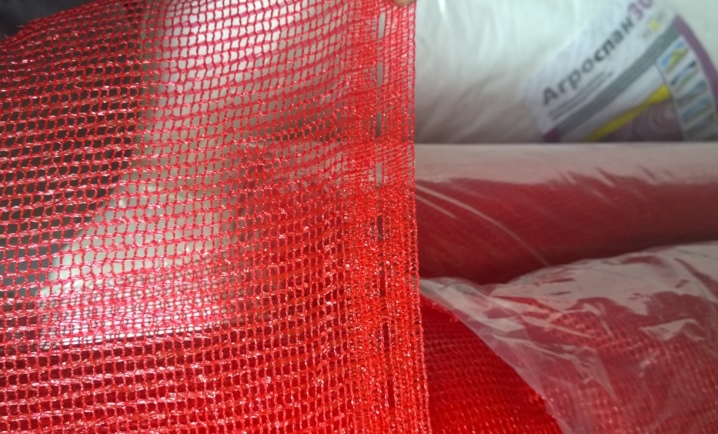
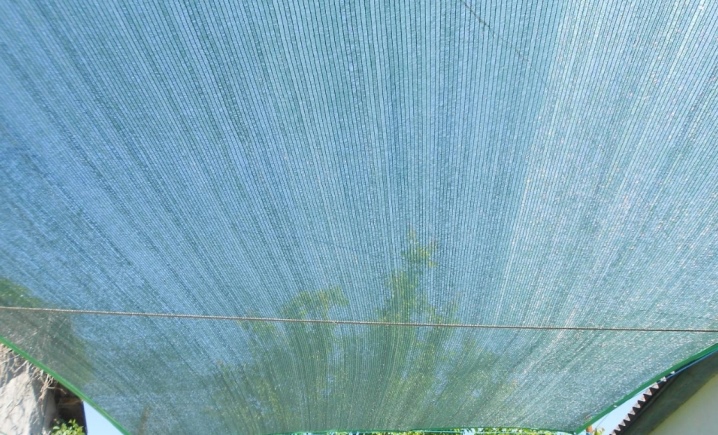
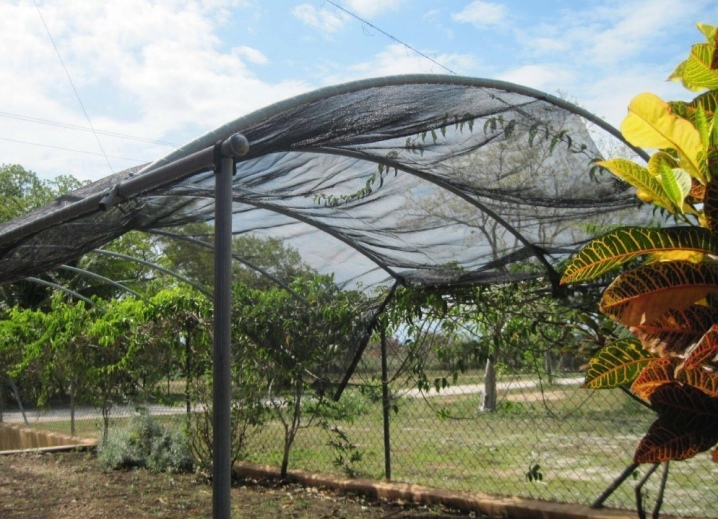
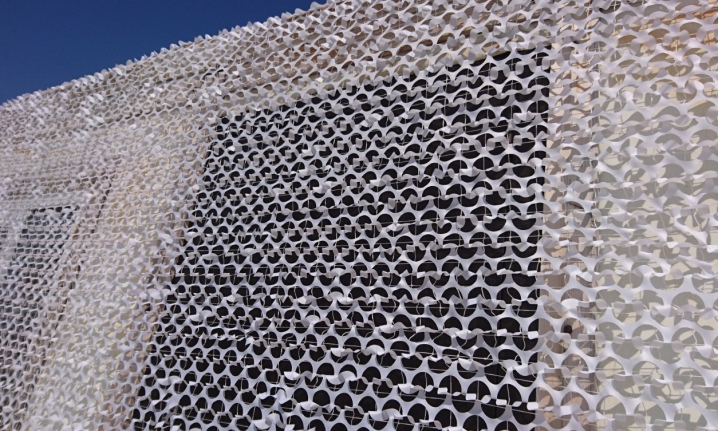
All of these factors are important. If you choose the wrong mesh, there is a risk of creating excessive darkening and the death of crops.
If you are camouflaging a car, tent or boat, there is always a chance that the object will be detected when choosing an insufficiently dense material.
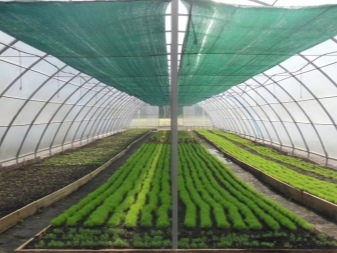
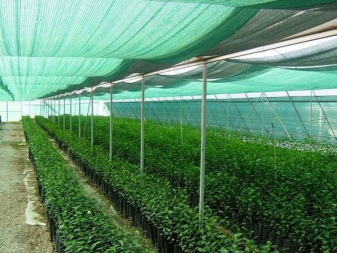
How to choose a grid for shading vegetables, see the video.
Camouflage (camouflage)
Camouflage or camouflage nets have long been used not only in military affairs. Previously, tanks, weapons, dugouts were covered with camouflage weaving.Such a shelter was difficult to identify with the naked eye from a distance. Today, camouflage netting can be used to cover the gazebo, thus creating the effect of a closed space. In addition, such a shelter will merge with grass and trees and become part of nature.
The gazebo is a valuable component of the recreation area. Find out how to make your own gazebo for a summer residence, and in particular from polycarbonate.
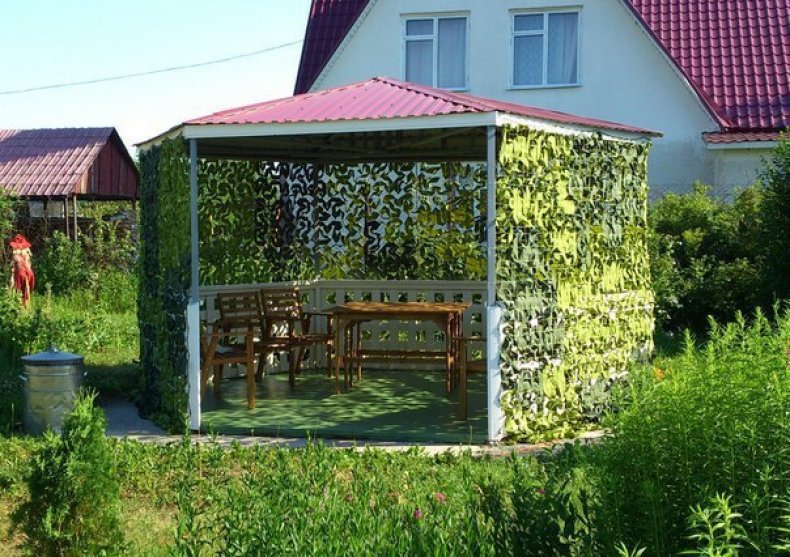
Important! Under the constant long-term influence of ultraviolet radiation, polyvinyl chloride can lose its strength and elasticity. For this reason, a special protective layer is applied to PVC.
Therefore, it is important not to remove it while cleaning the web.
Camouflage nets are one of the most popular types of gazebo cover today. After all, they perfectly protect from sunlight and unwanted neighborly glances, are relatively inexpensive and allow you to compactly cover a gazebo of any size and shape.
It is important to note that camouflage nets are divided into 2 types (relative to the basis on which the production takes place):
- polymers based on nylon;
- material that does not have a special reinforcing base.
It should be understood that the service life of the first type of shelter is much longer than the service life of the second. Accordingly, the price of a polymer-based chain will be higher. 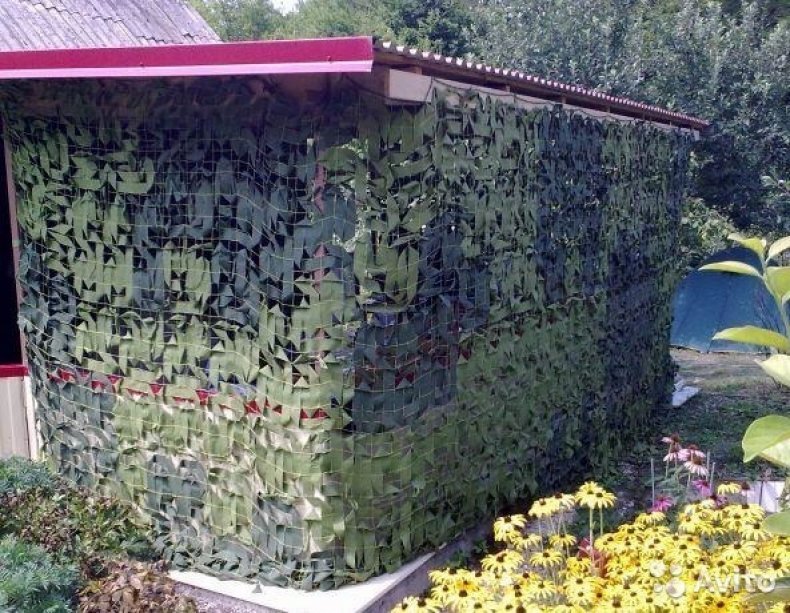
If we talk about the positive and negative qualities of such shelters for the gazebo, then it should be noted that there are much more pluses than minuses. Pros of a camouflage net:
- relatively low price;
- the ability to purchase at any fishing or hardware store;
- ease of use (you can cover the gazebo in just a few hours);
- high percentage of shading;
- polymer nets resistant to high humidity and frequent rainfall.
If you have a summer cottage and you like to create, learn how to make a beautiful garden swing, a barbecue made of stone, swans from tires, build a pool, make sculptures, build and equip a bathhouse, a waterfall, a fountain, gabions, and rockeries.
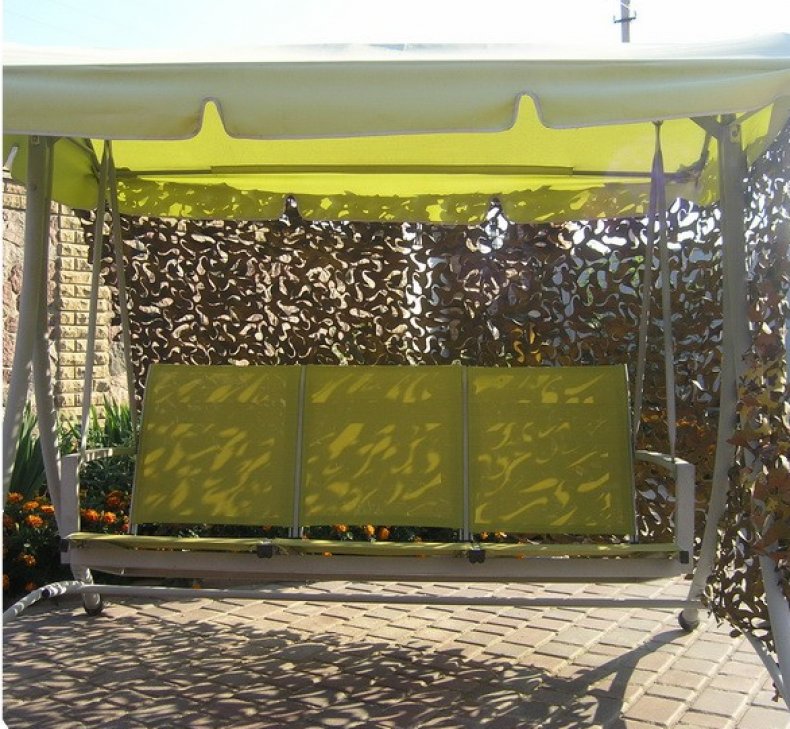
Specifications
When choosing an option for fencing a summer cottage, a chain-link or a mesh metal fence is often chosen. This is the most convenient and inexpensive fencing option to install.
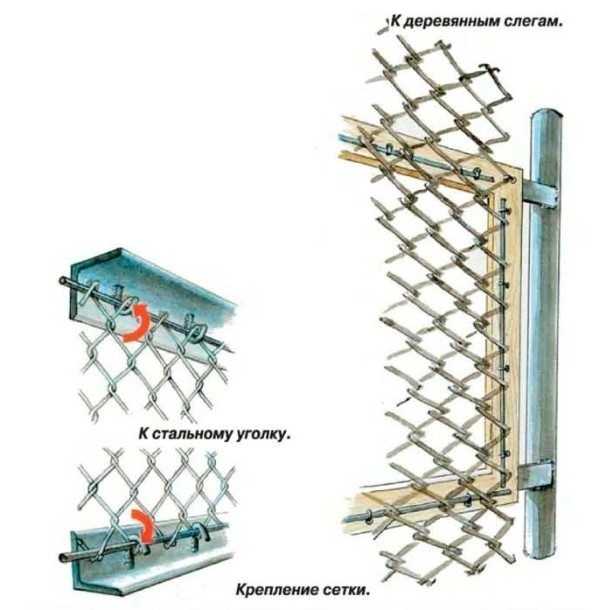 The sketch of the chain-link on the frame
The sketch of the chain-link on the frame
But such a fence has a drawback: it is almost transparent, behind it it will not be possible to hide from the gaze of neighbors and hide in the shade during the sun. Camouflage camouflage material for the fence will help to correct the situation.
Created for military purposes to camouflage objects and equipment, it has found application in everyday life due to its properties. The product is attractive, in harmony with the hedge. Due to this, it is widely used for organizing fences in country estates, zoning plots and decorating gazebos.
Taking into account the base, camouflage cloths for the fence are:
- with a frame - a canvas for a fence with a nylon thread, where the main material is fixed;
- without a frame - a budget option, which is a weave of ribbons made in the form of a mesh.
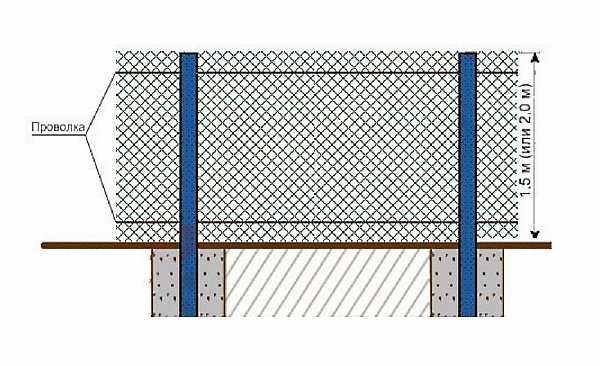 Wire fencing installation diagram
Wire fencing installation diagram
Frameless models are cheaper, but have a shorter operating time, in contrast to frame canvases.
By design, they are divided into the following types:
- Light - imitation of leaves on a mesh base. The product looks voluminous, soft and pleasant to the touch. This is the most popular option among the nets for summer residents. The material has good protection from direct sunlight, but at the same time it is well ventilated.
- The etalon is a universal canvas that is suitable for sheds, arbors, fences. Imitates pine branches fixed on a nylon base. The section of the cells is 60x60 mm. If there are coniferous trees on the site, you can safely choose these products. The material is available in colors ranging from white to green.
- Landscape - a canvas made of a mesh for a fence made of a durable material, on which a protective coating is applied.Due to this, the fabric is resistant to sunlight, water, temperature fluctuations, gusts of wind. The product contains symmetrical slots of different geometries.
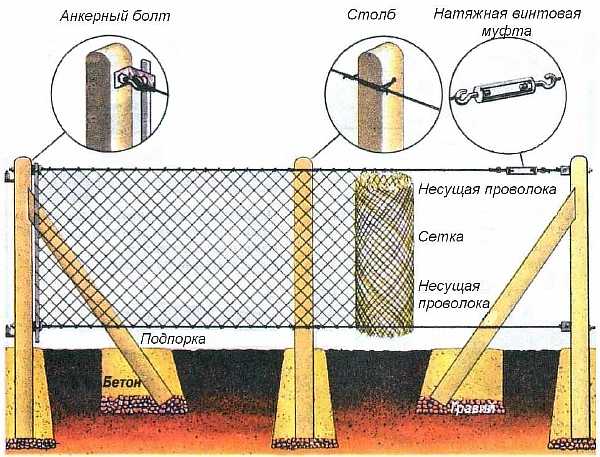 Wire mesh mounting sketch
Wire mesh mounting sketch
There are also:
- Fern - the material allows you to mask the fence in the color of this plant. Shades of different products range from sandy to bright green. Cell section - 50x50 mm.
- Econ is a heavy-duty fence ruler. The camouflage anti-reflective coating is made of a special fabric to which a polyurethane layer is applied. As a rule, the products are made in brownish-green color. Creates 60% shading.
- Econ-Profi is the most durable series of all fencing nets. Shades up to 97% dark and can be operated at -55 / + 55 ° C. It is widely used to decorate paintball fields, bars and restaurants.
You can determine the quality of the protective layer by looking at the inside of the fence mesh. The presence of scratches and other deformations indicates an incorrect manufacturing technology. You shouldn't buy such a product.
A photo of a camouflage fabric fence is shown below.
 Fencing in the country
Fencing in the country
Light transmittance
Camouflage camouflage material for the fence is classified into groups based on the amount of shadow created by the product:
- more than 90% - creates dense shading;
- 40–75% - the grid of this group forms a shade for a pleasant time, but does not allow to completely protect the territory from the sun's rays;
- up to 40% - creates minimal shading.
Taking this indicator into account, you can make a choice. For example, if you need to keep the sun on the site or if you plan to organize the beds.
The photo shows a camouflage fence.
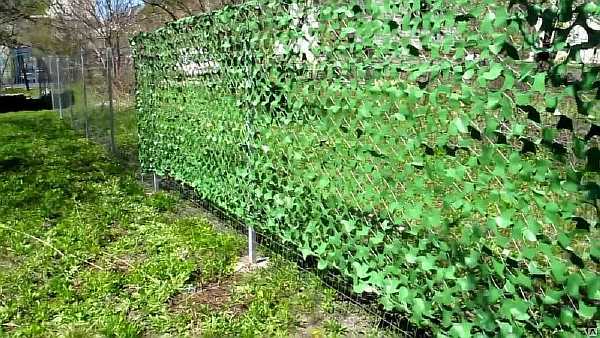 Protective option
Protective option
The cost of a camouflage net for a summer residence
The range of these products is constantly increasing, and new materials have replaced polyvinyl chloride. Reinforcement of camouflage nets for fences increases the cost, but in this case, the priority is the strength of the structure.
The cost is influenced by the materials used, the level of transparency and the external decor.
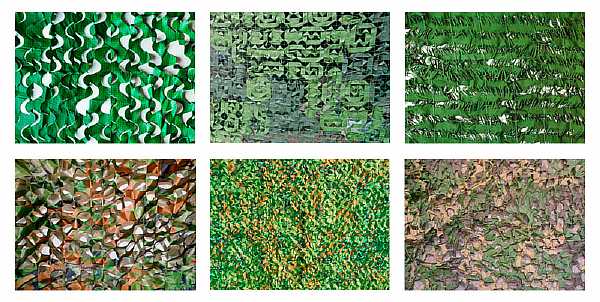 Variety of options
Variety of options
The approximate price of camouflage materials for the fence in the store "Leroy Merlin":
- "Standard", green, 3x18 m - 11,000 rubles.
- Linden, 300x1500 cm, with bast - 2700 rubles.
- "Needles", 2x3 meters (category "Fern") - 5000 rubles.
- "Grass", 2x3 meters, light beige - 4650 rubles.
- NorthWay, 3x1.5 meters, "Raffia Grass" - 2,400 rubles.
Wooden decorative
Wooden lattices for gazebos can be made by hand or ordered from a master. The price will depend on the complexity of the execution and the type of wood. So, the price of a linden lattice will be much higher than the price of a pine shelter. The fact is that linden is a more durable and reliable material, and is rarely used in woodworking.
Important! During combustion, PVC releases organochlorine compounds, carbon monoxide and other toxic substances. Therefore, when this substance ignites, the extinguishing operation should be carried out in a gas mask! The simplest way of execution is a cross lattice made of thin strips.
Such a lattice is attached to the frame, and the frame is then attached to the contours of the gazebo itself. Often, wooden decorative shelters are covered with a stain or varnish that reproduces the natural color of the wood. It should be understood that such shelters will be distinguished by a high degree of decorativeness, however, the protection from sunlight and insects will be slightly lower than in the first two cases.
The simplest way of execution is a cross lattice made of thin strips. Such a lattice is attached to the frame, and the frame is then attached to the contours of the gazebo itself. Often, wooden decorative shelters are covered with a stain or varnish that reproduces the natural color of the wood.It should be understood that such shelters will be distinguished by a high degree of decorativeness, however, the protection from sunlight and insects will be slightly lower than in the first two cases.

Shading will range from 40% to 70% (depending on the size of the mesh cells)
It is important to note that the smaller the cells, the thinner the slats.
And the thinner the slats, the more likely they can be mechanically damaged with the simplest carelessness
The positive qualities of decorative wooden shelters for gazebos are:
- aesthetics and the ability to create an exquisite shelter that fits perfectly into the decorative style of your garden;
- some types of wood can serve you as a trellis for more than 50 years;
- you can make such a shelter yourself, while spending only on building material.
- low protection from the sun and insects compared to a camouflage net;
- a fairly high price if you order a ready-made shelter from a master;
- the need to regularly cover the wooden grate with wood stain, varnish or special paint for wood.
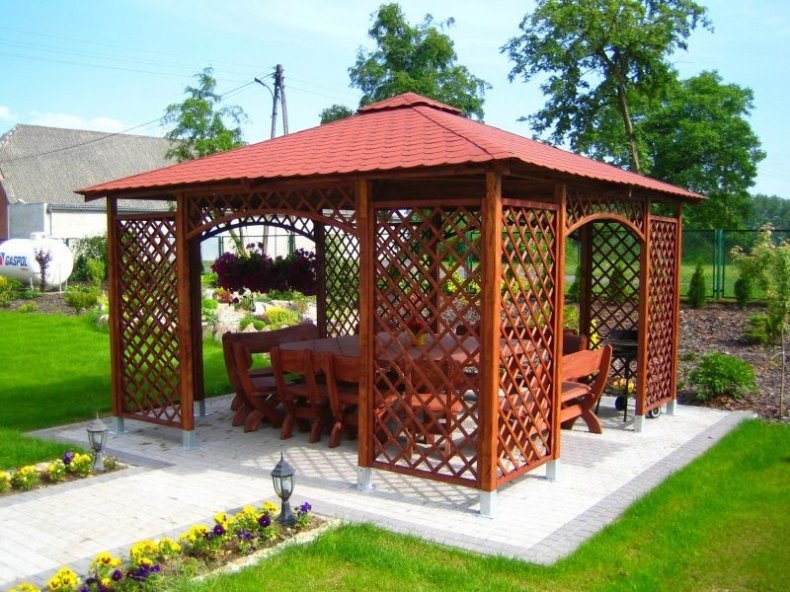
Fields of application: for gazebos, canopies, fence, summer cottages, from the sun, building facade protective and not only
Camouflage nets are used primarily to camouflage objects, equipment and people on the ground. But the scope is not limited to this.
Camouflage nets are used by individuals, the material is an excellent option for arranging a summer cottage, in particular:
- to complement a fence made of chain-link, welded mesh or other, non-wire materials and create harmony with the surrounding area; in addition, such a solution is an imitation of a hedge;
- for decorating a gazebo or veranda or terrace, arranging a cozy corner, closed from prying eyes and the rays of the hot sun;
- for arranging a carport, preventing rain and ultraviolet radiation from entering the vehicle.
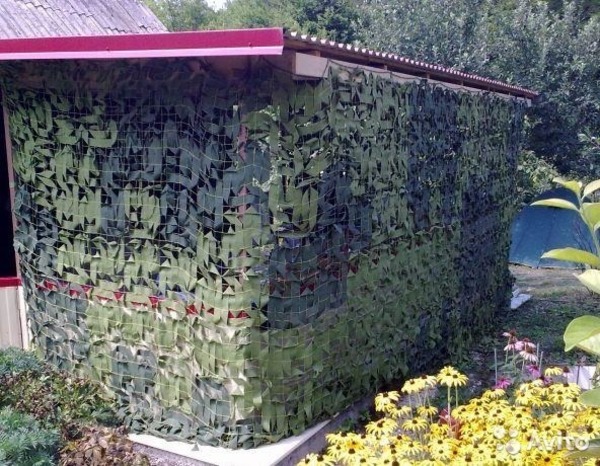
The camouflage net serves as a cover for the terrace. Photo Company K-A-M
Decorative chains are popular for decorating premises for various purposes: theme stores, bars, restaurants, photo studios, tourist centers, playgrounds, clubs, recreation areas. Moreover, the materials are suitable for both interior decoration and building architecture.
There is a special building facade mesh that protects the surrounding area from dust, debris and other waste flying from the forests. Alternatively, you can use a camouflage grid.
The masknet is also in demand among hunters. With the help of materials, camouflage of an ambush, shelters in the forest and in open areas is created at any time of the year. The mesh does not glare, easily attaches to bushes or special stands. The light weight and compact size of the collected material make it easy to carry the net in a bag or backpack.
Popular manufacturers
Below are the 4 most sought after camouflage manufacturers.
Nitex
The largest Russian manufacturer of camouflage goods. It offers many options for colors, cell shapes, so the buyer will always be able to find a product that is suitable for the intended purpose. The range of prices makes products available to everyone.

Duck expert
Russian manufacturer. It specializes in the production of hunting goods, including camouflage nets and clothing. In terms of quality, the products are not inferior to imported counterparts, but are much cheaper.
Siberia
The Russian company Siberia LLC produces and sells camouflage products. Individual orders for the manufacture of large quantities of products are accepted.
Camosystems
The famous brand, under which camouflage clothing, nets, hunting and fishing goods are sold. Country of origin - USA.
Description and purpose
The net is a textile fabric made on a net basis, some models are supplemented with patches of film or fabric fixed on the base.
Grids have a number of advantages:
- resistance to temperature extremes;
- water-repellent characteristics;
- combustion resistance;
- silent swaying in the wind;
- lack of glare under the bright rays of the sun.
In addition, the materials from which the nets are made are not susceptible to mold and mildew damage. They do not rot over time and do not lose their colors as they are used.
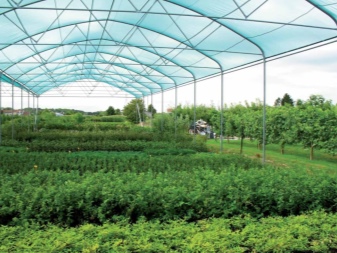
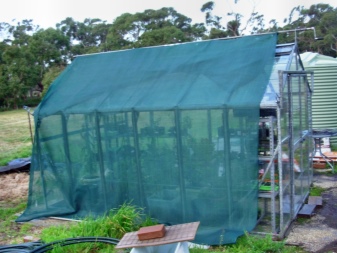
A mesh-based shelter has a beneficial effect on plants - the canopy effectively protects against UV radiation. However, it does not give full shade - the sunlight is evenly distributed over the entire area. Garden crops in this mode fully grow and develop, the fruiting period increases, and the yield increases. At the same time, the mesh allows water to pass through, but protects the seedlings from hail and strong winds.
The grids are used for the installation of canopies for gazebos, terraces and other recreation areas. Light weight and compactness allow you to take the covering material with you on picnics, trips to the country and even to the beach. The material effectively protects from wind and rain, shelters from annoying mosquitoes, allows heat to pass through, but at the same time does not aggravate the heat under the canopy. There is no greenhouse effect when using this material.
